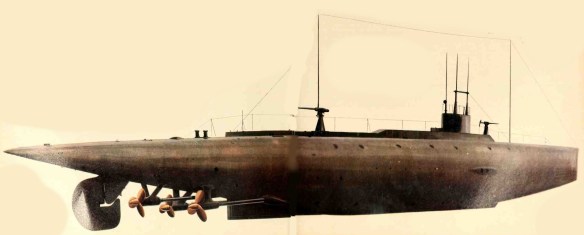
The British ‘J’ Class submarines had three-shaft diesel/electric engines which produced 3600 bhp/1400 hp. This gave them a surface running speed of 19 knots and a submerged speed of 9.5 knots-the fastest submarine class in the world at that time. The bulk of the vessels were presented to the Royal Australian Navy in March 1919.
The ‘J’ Class were double-hull submarines developed from the ‘G’ Class but some 500 tons larger in order to accommodate a heavier machinery plant for high speed. They were designed primarily to counter the incorrectly reported construction by Germany of 18-knot submarines and as. at the time, the diesel engine had reached its limit in size they were provided with three 1200-hp Vickers 12-cylinder diesels instead of the more usual two.
Their designed surface speed was 19.5 knots and at the time of their completion during 1916-17 they were the fastest submarines in the world. It was hoped that this high speed would enable them to operate with the main fleet but they were never so employed which, considering the later experience with the ‘K’ Class, was fortunate. They also had high endurance (6400 km [4000 miles] at 12 knots) and were equipped with long-range wireless for reconnaissance in enemy waters. As completed the casing was stopped short of the bow but several had this extended forward while the gun, originally mounted on the casing, was moved to a platform in front of the conning tower.
During World War I they served in the North Sea. The J – 6 was sunk in error off Blyth by the Q-ship Cymric on 15 October 1918. The remaining British boats were transferred to Australia in 1919. All the Australia boats were sold for scrap between 1924 and 1929.
J-1 (6 November 1915), J-2 (6 November 1915 Builder: Portsmouth DY
J-3 (4 December 1915), J-4 (2 February 1916) Builder: Pembroke
J-5 (9 September 1915), J-6 (9 September 1915), [Australia] J-7 (21 February 1917) Builder: Devonport
Displacement: 1204 tons (surfaced), 1820 tons (submerged)
Dimensions: 275’6” x 23’0” x 14’0”
Machinery: 3 Vickers diesel engines, 3 electric motors, 3 shafts. 3600 bhp/1350 shp = 19.5/9.5 knots
Range: 5000 nm at 12.5 knots surfaced; submerged characteristics unknown
Armament: 6 x 18” torpedo tubes (4 bow, 2 beam), total 12 torpedoes, 1 x 12-pounder gun, 1 x 30 AA gun
Complement: 44